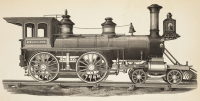








Richard Trevithick was a British inventor and mining engineer from Cornwall, UK.Born in the mining heartland of Cornwall, Trevithick was immersed in mining and engineering from a young age. The son of a mining captain, he performed poorly in school, but went on to be an early pioneer of steam-powered road and rail transport. His most significant contribution was to the development of the first high-pressure steam engine. He also built the first full-scale working railway steam locomotive. On 21 February 1804 the world's first locomotive-hauled railway journey took place as Trevithick's unnamed steam locomotive hauled a train along the tramway of the Penydarren Ironworks, in Merthyr Tydfil, Wales.
In the late eighteenth century,there were many wagonways and tramways in europe.
In 1802, Trevithick built one of his high-pressure steam engines to drive a hammer at the Pen-y-Darren Ironworks in Merthyr Tydfil, Mid Glamorgan . With the assistance of Rees Jones, an employee of the iron works and under the supervision of Samuel Homfray, the proprietor, he mounted the engine on wheels and turned it into a locomotive. In 1803, Trevithick sold the patents for his locomotives to Samuel Homfray.
Homfray was so impressed with Trevithick's locomotive that he made a bet with another ironmaster, Richard Crawshay, for 500 guineas that Trevithick's steam locomotive could haul ten tons of iron along the Merthyr Tydfil Tramroad from Penydarren (51°45?03?N 3°22?33?W) to Abercynon (51°38?44?N 3°19?27?W), a distance of 9.75 miles (16 km). Amid great interest from the public, on 21 February 1804 it successfully carried 10 tons of iron, 5 wagons and 70 men the full distance in 4 hours and 5 minutes, an average speed of approximately 2.4 mph (3.9 km/h).As well as Homfray, Crawshay and the passengers, other witnesses included Mr. Giddy, a respected patron of Trevithick and an 'engineer from the Government'.The engineer from the government was probably a safety inspector and particularly interested in the boiler's ability to withstand high steam pressures.
The configuration of the Pen-y-darren engine differed from the Coalbrookdale engine. The cylinder was moved to the other end of the boiler so that the firedoor was out of the way of the moving parts. This obviously also involved putting the crankshaft at the chimney end. The locomotive comprised a boiler with a single return flue mounted on a four wheel frame. At one end, a single cylinder with very long stroke was mounted partly in the boiler, and a piston rod crosshead ran out along a slidebar, an arrangement that looked like a giant trombone. As there was only one cylinder, this was coupled to a large flywheel mounted on one side. The rotational inertia of the flywheel would even out the movement that was transmitted to a central cog-wheel that was, in turn connected to the driving wheels. It used a high-pressure cylinder without a condenser, the exhaust steam was sent up the chimney assisting the draught through the fire, increasing efficiency even more.
The bet was won. Despite many people's doubts, it had been shown that, provided that the gradient was sufficiently gentle, it was possible to successfully haul heavy carriages along a "smooth" iron road using the adhesive weight alone of a suitably heavy and powerful steam locomotive. Trevithick's was probably the first to do so;however some of the short cast iron plates of the tramroad broke under the locomotive as they were intended only to support the lighter axle load of horse-drawn wagons and so the tramroad returned to horse power after the initial test run.
Homfray was pleased he won his bet. The engine was placed on blocks and reverted to its original stationary job of driving hammers.
In modern Merthyr Tydfil, behind the monument to Trevithick's locomotive is a stone wall, the sole remainder of the former boundary wall of Homfray's Penydarren House.
A full-scale working reconstruction of the Pen-y-darren locomotive was commissioned in 1981 and delivered to the Welsh Industrial and Maritime Museum in Cardiff; when that closed, it was moved to the National Waterfront Museum in Swansea. Several times a year it is run on a 40m length of rail outside the museum.
In 1808, Trevithick publicised his steam railway locomotive expertise by building a new locomotive called 'Catch me who can', built for him by John Hazledine and John Urpeth Rastrick at Bridgnorth in Shropshire, and named by Davies Giddy's daughter. The configuration differed from the previous locomotives in that the cylinder was mounted vertically and drove a pair of wheels directly with the connecting rods, without flywheel or gearing. This was probably Trevithick's fourth locomotive, after those used at Coalbrookdale, Pen-y-darren ironworks and the Wylam colliery. He ran it on a circular track just south of the present day Euston Square tube station in London. The site in Bloomsbury has recently been identified archaeologically as that occupied by the Chadwick Building, part of University College London.
Admission to the "steam circus" was one shilling including a ride and it was intended to show that rail travel was faster than by horse. This venture also suffered from weak tracks and public interest was limited.
Trevithick was disappointed by the response and designed no more railway locomotives. It was not until 1812 that twin cylinder steam locomotives, built by Matthew Murray in Holbeck, successfully started replacing horses for hauling coal wagons on the edge railed, rack and pinion Middleton Railway from Middleton colliery to Leeds, West Yorkshire.